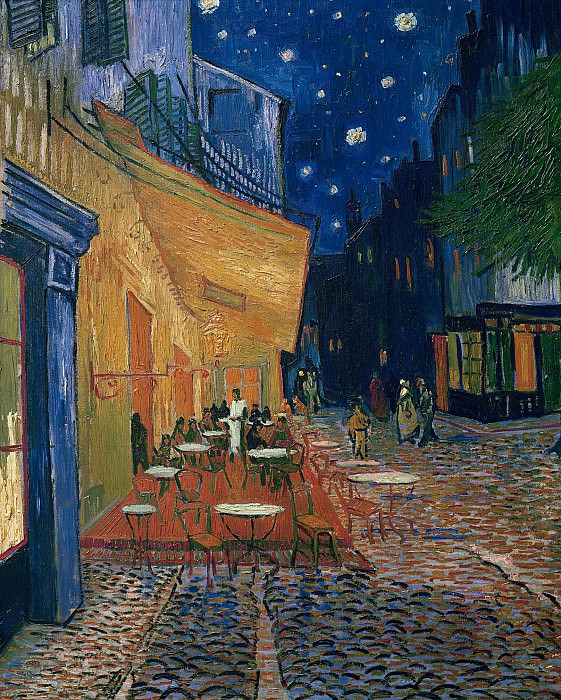Cafe Terrace in Arles at Night Vincent van Gogh (1853-1890)
Vincent van Gogh – Cafe Terrace in Arles at Night
Edit attribution
Download full size: 1616×2017 px (0,9 Mb)
Painter: Vincent van Gogh
Location: Kröller-Müller Museum, Otterlo.
Van Gogh did not use black paint at all in his painting Night Cafe Terrace. But hardly anyone would argue that the canvas does not depict the night time. This canvas was created during the so-called Arles period of the painter’s work (at that time the yellow palette was clearly predominant in the artist’s works). This canvas also confirms the presence in abundance of the author’s favorite color. Looking closely at the canvas, you can even feel that this color shade, overflowing with a very rich and bright glow, which, as if appears from the inner depths of the canvas, decisively denying the ordinary everyday life and boredom. There are suggestions that during the creation of this painting Van Gogh tried a fundamentally new approach to the reproduction of the surrounding reality: he painted a night terrace not in his studio, as everyone usually did, but worked directly under the night sky.
Description of Vincent van Gogh’s painting Cafe Terrace
Van Gogh did not use black paint at all in his painting Night Cafe Terrace. But hardly anyone would argue that the canvas does not depict the night time. This canvas was created during the so-called Arles period of the painter’s work (at that time the yellow palette was clearly predominant in the artist’s works). This canvas also confirms the presence in abundance of the author’s favorite color.
Looking closely at the canvas, you can even feel that this color shade, overflowing with a very rich and bright glow, which, as if appears from the inner depths of the canvas, decisively denying the ordinary everyday life and boredom.
There are suggestions that during the creation of this painting Van Gogh tried a fundamentally new approach to the reproduction of the surrounding reality: he painted a night terrace not in his studio, as everyone usually did, but worked directly under the night sky. As is known from journalistic reports, the artist used candles attached to his hat to work in the dark for the purpose of illumination.
There is no factual evidence to support such an unorthodox headdress. Only once is it mentioned in the correspondence, where the author notes the unfair approach to the role of a single candle, while it is enough to exclude the appearance of "the traditional night, with whitish and cold light ...".
Researchers and critics view the entire composition "Terrace Cafe" as a version very similar to Anquetin’s famous work "Avenue de Clichy in the evening". And in general, Van Gogh’s Café Terrace is dominated by a purely positive attitude, precisely because of the very original lighting solution, which allows the average viewer to perceive the canvas as an object of material and spiritual values.
Кому понравилось
Пожалуйста, подождите
На эту операцию может потребоваться несколько секунд.
Информация появится в новом окне,
если открытие новых окон не запрещено в настройках вашего браузера.
You need to login
Для работы с коллекциями – пожалуйста, войдите в аккаунт (open in new window).














COMMENTS: 3 Ответы
online games here
Я могу на этот шедевр смотреть вечно
Восхитительно
You cannot comment Why?
The painting evokes a sense of warmth and conviviality emanating from the cafe, contrasting with the cooler, darker atmosphere of the surrounding night. The use of vibrant colors, particularly the yellow of the awning and the blue of the sky, creates a dynamic and emotional visual experience. The stars, rendered with thick brushstrokes, give a sense of celestial wonder.
One subtext could be the artists attempt to capture the beauty and atmosphere of everyday life, even at night, and to portray the shared human experience of gathering and socializing. The contrast between the brightly lit cafe and the dark, quiet street might symbolize the comfort and human connection found in illuminated spaces amidst the vastness of the night. Additionally, the prominent stars can be interpreted as a reflection of van Goghs fascination with the cosmos and his spiritual contemplation, perhaps a yearning for something beyond the earthly realm. The solitary figures walking in the background, contrasted with the animated scene at the cafe, could also suggest a commentary on different forms of human experience – connection versus isolation.